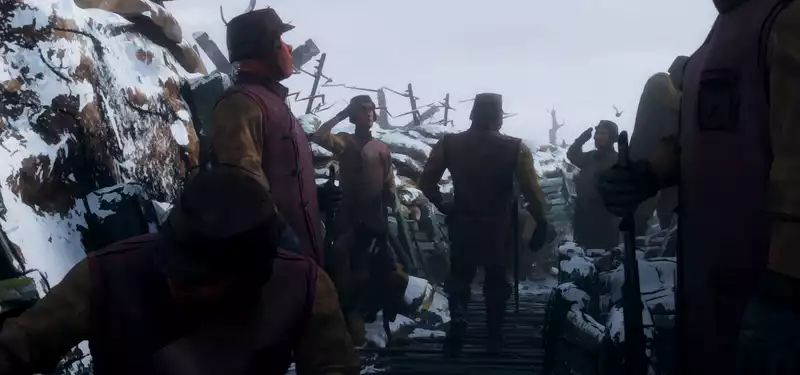Jan 8, 2024
Oscar Nominee Interview: Director Dave Mullins on His Favorite Shots from War Is Over! (Exclusive Interview), talks about his favorite shot of "War Is Over!
We invited the makers of the 15 films nominated for this year's Academy Awards for Best Animated Short to share their favorite shots from their films and why. Each film is listed in the order in which the materials were received.
In this piece, we take a look at "War Is Over. Inspired by the Music of John and Yoko" by filmmaker Dave Mullins, who was once nominated for an Academy Award for Best Animated Short Film for his work on the Disney-Pixar film "Lou."
"War Is Over" is set in an alternate universe of World War I, where two soldiers on opposing sides play a chess game. Overhead, as the fighting continues, a carrier pigeon delivers the soldiers' hands from trench to trench.
Below, Mullins introduces his favorite scene from the short and tells us what it means:
This was the first shot that came to my mind when I was writing the script for War is Over. John and Yoko's anti-war message was the whole reason I made the film, so I wanted a shot early on that expressed that message from an emotional point of view. I also wanted this shot to serve as a stylistic touchstone for the other shots, letting the audience know what kind of film they were about to see. For me, this shot is a tribute to some of my favorite filmmakers, including Hayao Miyazaki, Ridley Scott, and Stanley Kubrick. It is this kind of visual language that makes their films so engaging and re-watchable.
One way to really make a shot like this stand out is to combine two primal elements on screen. It's like the haiku of filmmaking. A simple example of this is when we see a burned out car. A car and a fire. We immediately know what happened. The story can be understood by anyone, no matter what language they use. It is visual.
In "War is Over," I used blood and snow as the two primal elements. The shot begins on freshly fallen snow, with a sergeant stepping through the frame, leaving a blood-filled boot print. It immediately conveys how long the war has been going on and the conditions the soldiers are in. These two elements combine to give us a great deal of information.
We also wanted to quickly establish the relationship between the sergeant and the soldiers. The chain of command is very important to the film. We needed to illustrate the suffering and terrible conditions they were living in. It's snowing and there's a frozen fog mixed in. [It was skillfully crafted by production designer Zach Letts and the team of visual effects supervisor Keith Miller of W.t.FX.
From a camera and performance standpoint, I developed the shots onstage with cinematographer Antonio Riestra. I then continued to develop the look of the shot at W.t. FX with Aidan Martin (animation supervisor) and David Scott (digital cinematographer).
Finally, by layering the elements, we see the main character, a pigeon, flying low near the trenches and the soldiers closely involved in the war effort. She is not above the fray, but part of it.
It's a lot to pack into one shot, but in less than eight seconds we are introduced to war, the harsh environment, the sergeants and soldiers, the chain of command, the role of the pigeons in the war, and the hell they all live through. All of this describes the human condition and its place in the horrors of war.
With all that is happening around the world today, we wanted to get this message right, both emotionally and visually. While these shots focus on the hell of war, we hope that audiences will truly feel in the theater the message of peace that John and Yoko sang so passionately about over 50 years ago.
Read other entries in the series so far:
.



Post your comment